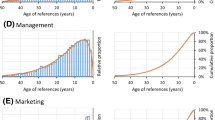Abstract
A growth model of the journal literature is proposed and applied to the growth of the literature of theoretical population genetics (1850–1980).
Similar content being viewed by others
References
D. J. De S. Price,Science since Babylon, New Haven, Connecticut, Yale University Press, 1961.
D. J. De S. Price,Little Science, Big Science, New York, Columbia University Press, 1963.
E. M. Rogers,Diffusion of Innovations, New York, Free Press of Glencoe, 1962.
J. S. Coleman, E. Katz, H. Menzel,Medical Innovations: A Diffusion Study, Indianapolis, Bobbs-Merrill, 1966.
D. Crane,Invisible Colleges: Diffusion of Knowledge in Scientific Communities, Chicago, The University of Chicago Press, 1972, p. 213.
G. Holton, Models for understanding the growth and excellence of scientific research. In:S. R. Graubard, G. Holton (Eds),Excellence and Leadership in a Democracy, New York, Columbia University Press, 1962, pp. 94–129.
F. Reif, A. Strauss, The impact of rapid discovery upon the scientist's career,Social Problems, 12 (5) (1965) 297–311.
B. C. Griffith, N. C. Mullins, Coherent social groups in scientific change,Science, 177 (1972) 961.
W. O. Hagstrom,The Scientific Community, New York, Basic Books, 1965.
Vijay Mahajan, R. A. Peterson,Models for Innovation Diffusion, London, Sage Publications, 1985.
E. Mansfield, Technical change and the rate of imitation,Econometrica, 29 (1961) 741–766.
F. M. Bass, A new product growth model for consumer durables,Management Science, 15 (1969) 215–227.
J. D. Sterman, The growth of knowledge: Testing a theory of scientific revolutions with a formal model,Technological Forecasting and Social Change, 28 (1985) 93.
Ashok Jain, K. C. Garg, Laser research in India: Scientometric study and model projections,Scientometrics, 23 (1992) 395–415.
K. C. Garg, Praveen Sharma, Lalita Sharma, Bradford's law in relation to the evolution of a field: A case study of solar power research,Scientometrics, 27 (1993) 145–156.
J. Falsenteen,Bibliography of Theoretical Population Genetics, Pennsylvania, Dowden, Hutshinson & Ross, Inc., 1981.
Lalita Sharma, Aparna Basu, S. C. Bhargava, A new model of innovation diffusion,Journal of Scientific and Industrial Research, 52(3) (March 1993) 151–158.
S. C. Bhargava, Ashok Jain, Lalita Sharma, Mathematical modelling of manpower growth: Application to growth of post-graduates and doctorates in natural sciences in India,Journal of Scientific and Industrial Research, 53(3) (March 1994) 143–172.
Praveen Sharma, S. C. Bhargava, A non-homogenous non-uniform influence model of innovation diffusion,Technological Forecasting and Social Change, 46 (1994) 279–288.
Author information
Authors and Affiliations
Rights and permissions
About this article
Cite this article
Gupta, B.M., Sharma, L. & Karisiddappa, C.R. Modelling the growth of papers in a scientific specialty. Scientometrics 33, 187–201 (1995). https://doi.org/10.1007/BF02020568
Received:
Issue Date:
DOI: https://doi.org/10.1007/BF02020568




